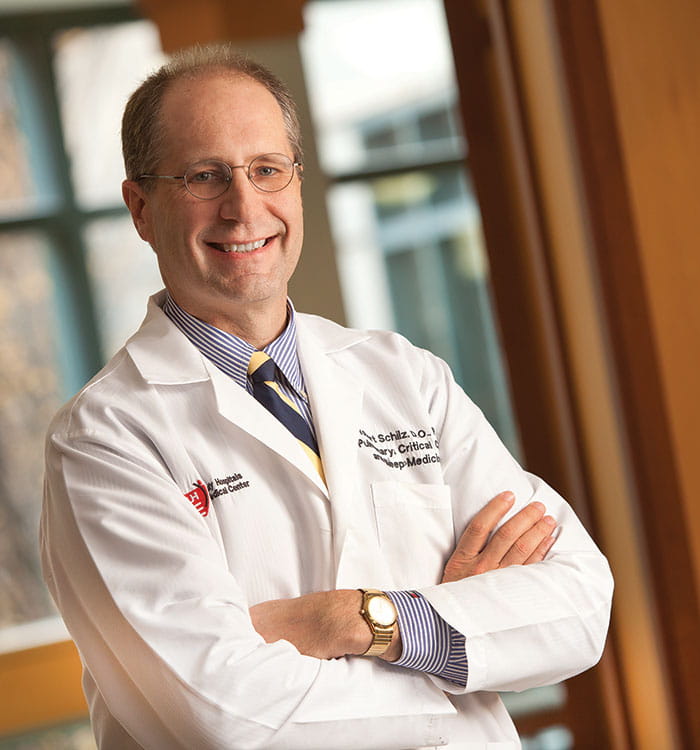Innovative Treatments for Emphysema-related COPD
October 16, 2019
Lung volume reduction surgery at University Hospitals offers significant benefits for the right patients
Innovations in Pulmonology & Sleep Medicine | Fall 2019
Chronic obstructive pulmonary disease (COPD), a progressive lung disease marked by worsening breathlessness, is the third most common cause of death in the United States. It’s also challenging for physicians to treat. Pulmonology & Sleep Medicine at University Hospitals Cleveland Medical Center is leading the way in bringing therapeutic options to COPD patients.
 Robert Schilz, DO, PhD
Robert Schilz, DO, PhD
LUNG VOLUME REDUCTION SURGERY
For the most seriously ill patients with emphysema-related COPD, a lung transplant is the best option. Some patients, however, are not quite that ill but still have severe emphysema with profound limitations in both physical activity and quality of life. For qualified patients, lung volume reduction surgery (LVRS) is a viable treatment option, says Robert Schilz, DO, PhD., Director of the Pulmonary Vascular Disease Program and Lung Transplantation at UH Cleveland Medical Center; and Associate Professor of Medicine, Case Western Reserve University School of Medicine.
Smoking-related emphysema destroys large sections of lung tissue, leaving them essentially useless. The idea behind LVRS — removing approximately 20 percent of the most damaged lung tissue in people who struggle to breathe — is almost counterintuitive, says Dr. Schilz. But it works.
“In the right patients, if you get rid of the bad lung tissue to make more room for the rest of the healthier lungs, the patients feel better, they can walk farther and they live longer,” Dr. Schilz says. “LVRS is only relevant for a small percent of people with smoking-related lung damage, but if you correctly pick those people, they have really dramatic outcomes.”
The National Emphysema Treatment Trial (NETT), a multicentered trial completed in 2003, found that on average, patients who underwent LVRS along with medical therapy functioned better after two years compared with patients who received medical therapy only. NETT also demonstrated that patients whose emphysema was mostly confined to the upper lobes and who had low exercise capacity were ideal candidates for LVRS.
“Dr. Linden [Philip Linden, MD, Chief of the Division of Thoracic and Esophageal Surgery at University Hospitals and University Hospitals Seidman Cancer Center] and I were original investigators in the NETT trial,” says Dr. Schilz. “As part of that group, we helped define who LVRS should be used for and how it should be used.”
Now with 20 years of experience, Dr. Linden continues to perform lung volume reduction surgeries at UH, and Dr. Schilz continues to identify and select people who could benefit from this surgery.
HIGH-TECH TWIST FOR LUNG VOLUME REPLACEMENT
The past 18 months has brought another innovation to lung volume reduction: endobronchial valves (EBVs).
“Instead of surgically removing damaged lung tissue, we place four to seven removable one-way valves in carefully selected branches of the airways using flexible bronchoscope,” says Dr. Schilz. “These valves deflate the damaged sections of lung, keeping air out but allowing the patient to exhale secretions and trapped air that might lead to decreased lung volume or atelectasis of the lung or lobe.”
The Food and Drug Administration has recently approved two endobronchial valves for lung volume replacement: ZephyrⓇ EBV (Pulmonx) and SpirationⓇ Valve System (Olympus). Several trials showed improved lung function and exercise capacity in patients who have these valves. With the Zephyr valve, the patients who get the most clinical benefit are those with complete fissures (identified on imaging), which is a surrogate for assessing collateral ventilation.1
UH’s endobronchial valve program for emphysema-related COPD is multidisciplinary. In addition to Dr. Schilz and Dr. Linden, Benjamin Young, MD, Director of Interventional Pulmonology at UH Cleveland Medical Center; and Assistant Professor of Medicine, School of Medicine and Catalina Teba, MD, Division of Pulmonary, Critical Care and Sleep Medicine at UH Cleveland Medical Center; and Assistant Professor of Medicine, School of Medicine, also serve on the team and perform this procedure.
Only a few centers in Ohio evaluate patients and offer both LVRS and endobronchial valve procedures, as well as lung transplantation, in patients with advanced disability due to smoking-related lung disease. Fortunately for COPD patients in the Cleveland area, UH is one of them.
For more information, or to refer a patient for LVRS or endobronchial valve placement, contact Dr. Schilz in the Division of Pulmonary and Critical Care Medicine at 216-553-1649.
1Endobronchial valves for lung volume reduction: What can we offer patients with advanced emphysema?, Chest Physician.


